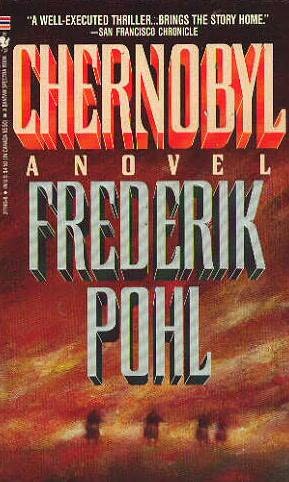

| CHERNOBYL Frederik Pohl New York: Bantam Books, September 1987 |
Rating: 5.0 High |
|||
| ISBN-13 978-0-533-05210-7 | ||||
| ISBN-10 0-533-05210-1 | 355pp. | HC | $18.95 | |
One very effective way to bring home the importance of a historical event is to dramatize it. Veteran science-fiction writer Frederik Pohl has done that with the Chernobyl reactor #4 accident of 26 April 1986. His novel1 about the tragedy places it in a context of human bravery and foibles, making it memorable and understandable. His work also illuminates parts of the larger context of the times: The oppressive security in Russia, the stark contrast between Communist Party officials and ordinary folks, the prevalence of alcohol consumption,2 types of Russian automobiles,3 the distorted picture Russians had of America.
Pohl says some of the names in his novel are real.4 It would be nice to know which those are. Aside from the obvious ones — Stalin, Marx, Engels, Khrushchev, Brezhnev, Andropov, Gorbachev — I picked up only two: Felix Dzerzhinsky, who founded the Cheka (later known as the KGB), and film director Elim Klimov.
And then there are the other accidents: A 1958 Yugoslav nuclear accident (p. 235) which injured 5 men, who got the first bone-marrow transplants; 5 workers exposed at Cap La Hague in France; an accident earlier that same year at another plant in France, when control power was lost (page 321) and the first backup diesel generator failed (the second worked.); and of course Kyshtym, which is mentioned twice in the novel but never described. That 1957 disaster5 closely resembles Chernobyl in its effects and in the way news about it was withheld. (Chernobyl differs because it directly involved a reactor, and because its effects reached into Europe so the news broke much sooner in the West.)
Here's a table showing the other accidents Pohl's novel mentions, along with my coverage (if any) in "Incidents Involving Nuclear Energy." (I'm unable to find a match for the first incident from 1986, which the novel mentions on page 321.)
| Page | Place | Goof # | Date | Notes |
|---|---|---|---|---|
| 235 | Yugoslavia | 070 | 15 Oct 1958 | Six men irradiated at Boris Kidrich Institute in Vilna. Five recover. |
| 321 | France | ??? | 1986 | French reactor loses control power. First backup diesel generator will not start. Second does start, averting a meltdown. |
| 321 | France | 486 | 20 May 1986 | Five workers irradiated at Cap La Hague processing plant. |
| ? | Russia | 053 | 29 Sep 1957 | Kyshtym. The novel mentions this twice but never describes it. See footnote 5. |
Perhaps the best single real event described in the story is the sortie under water — and under the damaged core of reactor #4 — to free drainage valves so the plenum can be drained and filled with concrete. Pohl says in his afterword that the three men who actually carried this out were Alexei Ananenko, Valeriy Bezpalov, and Boris Baranov. Heroes all.
"The inhabitants of the settlement near the station were evacuated within a matter of hours and then, when it had become clear that there was a potential threat to the health of people in the adjoining zone, they also were moved to safe areas." – Mikhail Gorbachev, quoted on page 286 |
From the Chernobyl disaster and other actual events, and from his deep knowledge of Russian culture,6 Frederik Pohl has woven a gripping tale. It is worth reading even now, long after the impact of Chernobyl has begun to fade.

 To contact Chris Winter, send email to this address.
To contact Chris Winter, send email to this address.